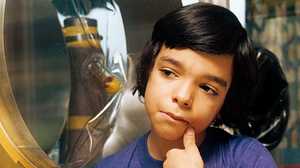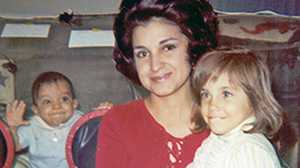David Phillip Vetter (1971-1984)

David Vetter's favorite color was purple. He had a pet duck. He loved the original Star Wars films. His favorite foods were spaghetti, lasagna and chocolate cake. He loved to hold the mixer and help his mother bake. He loved watching Houston Oilers games on television with his dad — because he picked up new vocabulary from his father whenever the hapless home team made another error. He was a well-behaved child who occasionally fought with his sister and sassed his parents.
David's entire life was spent inside a plastic isolator bubble to protect him from the germs that his body could not fend off.
Born Without an Immune System
David Vetter was born with severe combined immunodeficiency (SCID), meaning his body had no immune system to fight off diseases of any sort. Because his older brother had died from complications of the same disease, his parents were prepared for David's birth and arranged for a germ-free delivery on September 21, 1971, at Texas Children's Hospital in Houston. Once it was determined that David was also afflicted with SCID, he stayed in plastic isolator bubble environments while waiting for a matching bone marrow donor or a cure for his ailment. The long wait would last twelve years.

At Home in a Bubble
In the first years of his life, David spent as much time at the hospital as he did at home, but later he was able to live in an isolator at home, visiting the hospital only for check-ups. His neighbor Shawn came over to play games, watch television and make prank calls with David. David's older sister Katherine played and spent time with her brother, and for the first nine years of his life, whenever he was home, she slept next to the bubble.
Schooling
David's schooling came through home visits at first, and then through telephone speakerphone to a classroom. Although he was a good student, David would "lose" his pencil so he didn't have to go to class. "But I knew all the hiding places in the bubble," his mother said, "and the lost pencils were soon retrieved." Doing his homework could be frustrating, especially before engineers at NASA developed a method to sterilize his pencil's erasers. Before then, David would get frustrated at how marked up his papers were and sometimes throw a tantrum.
Inside Looking Out
Summer vacations were particularly difficult for David when he could see other children playing outside while he was confined to his room.
Brave, Loveable, Pensive
The facts of David's emotional life are the subject of dispute, although most would agree with a member of his Texas hospital team, Dr. Jack Montgomery, that "he was a strange combination of a very lovable child and an almost adult toughness and bravery." Psychiatrist David Freedman described the six-year-old David as a "well-integrated personality and ... emotionally strong." His mother Carol Ann remembers David as upbeat and courageous. "He never felt handicapped or cheated, and never said, 'Why me?'" But when David was nearing puberty, and his closest contemporaries were both teenagers with less time to spend with him, his mother noticed that "David seemed to be growing more pensive. This showed in his expressive eyes. He became more secretive and really wouldn't share his thoughts with anyone."
Darker Moods
While his mother acknowledged David's occasional bad moods, Mary Murphy, a psychologist at the hospital, saw darker undercurrents. While he could be unfailingly polite to other staff members, Murphy feels that he was more open with her. "Why am I so angry all the time?" she remembers him asking her. "Whatever I do depends on what somebody else decides I do ... Why school? Why did you make me learn to read? What good will it do? I won't ever be able to do anything anyway. So why? You tell me why." While any thoughtful person may wonder whether their life has meaning, coming from David it became a question of bioethics, accusatory as well as philosophical.
Keeping Things Upbeat
The people who knew and loved David differ strongly in their memory of him. Undoubtedly, their responsibilities and decisions affected their emotional ties and their memories of their relationships. Mary Ann South, one of his original three doctors told a reporter recently, "In order for David's life to be most meaningful, his parents and we all tried to be upbeat about it even though we knew that things were wrong."
His Death
David became sick after a bone marrow transfusion was performed a month following his twelfth birthday. He was never physically a prisoner in the bubble; he had merely understood the dangers the outside environment posed to his system. In early 1984, on the advice of doctors, he left his bubble to receive medical treatment. Fifteen days later, on February 22, David died.







